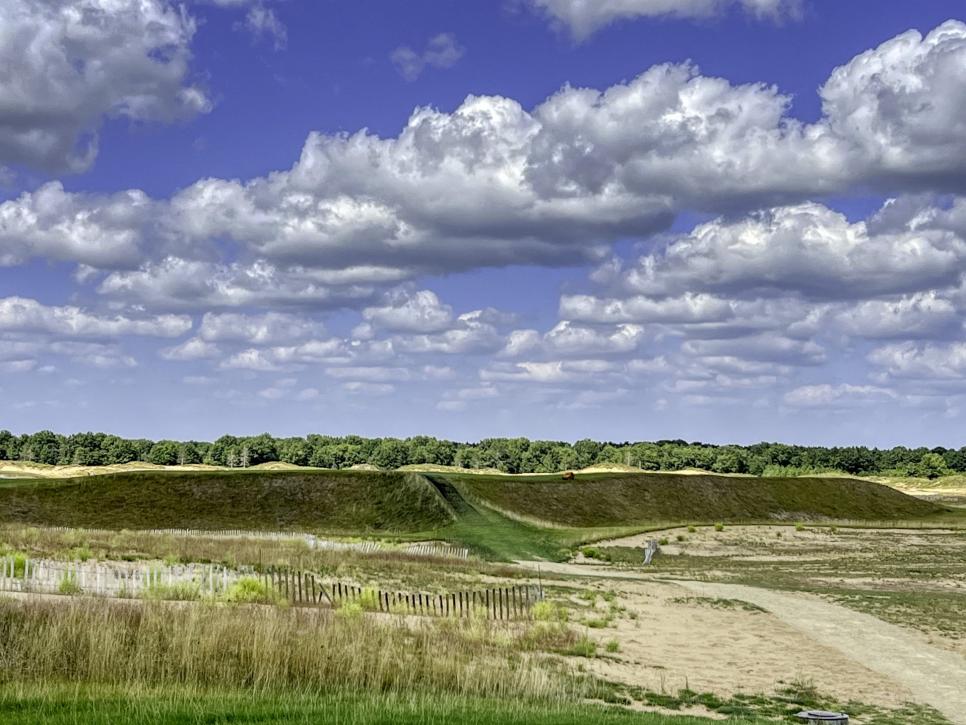First Look
I got to play the new Lido course at Sand Valley. Here’s what makes it so unique

The Lido at Sand Valley Resort, opened this June, has been one of the most anticipated and publicized new courses in recent years.
The reason is twofold. The first is because it’s an uncommonly bare, muscular and intensely shaped design that defies easy comparison. As depicted on social media, magazines and elsewhere, the Lido shows dramatic, almost alien shapes of grass that seem to materialize kinetically from sandy plains.
The second is because of its backstory: The Lido is a frame-by-frame recreation of the course that C.B. Macdonald built in 1917 on Long Island that went out of existence in the 1940s when the land was converted to a naval base.

The "Alps" green at 10 (foreground) and the par-4 11th "Lagoon" beyond.
Brandon Carter
Many observers considered the Lido one of the best in the country during its prime in the 1920s. Since its demise it’s been the object of infatuation for golf historians who have pored over photographs of its features like the wreckage of the Titanic and pondered how the course must have appeared to golfers of the era. Michael and Chris Keiser, the developers of Sand Valley, decided to do more than wonder: They brought together a diverse team to rebuild the original seaside design as closely as possible at their central Wisconsin resort using a combination of computer simulation, new mapping technology, GPS guided bulldozers and the architectural guidance of Tom Doak and his associates.
The results are as physically spectacular as any Lido historian could have dreamed and as disorienting as if being awakened suddenly on the shore of the Atlantic Ocean of Long Island during the final months of World War I, the strange formations pirouetting amid a nearly directionless field of golf.
The Lido, as reconstructed, instantly becomes one of the most unique and fascinating experiences in American golf. It’s also one of the most baffling. Understanding it requires study and familiarity, and grasping some of its basic precepts may be the key to unlocking its mysteries—and its pleasures.

The putting surface at the par-4 first is blind even from an ideal fairway posiition.
BLINDNESS
Never has a golf course been more misrepresented by modern photography than the Lido.
Drone shots present the Lido as ordered Tetris blocks of fairways and greens connected around gaps of open sand, each contour, slope, bunker and avenue rendered in vivid detail. Delineated humps and hollows, accentuated by low light and long shadows, appear to form an inviting gameboard of chutes and pathways. The opposite is true when playing the course. The scenery is vague and disorienting, the colors, landforms and presumed holes blurring together. A common refrain is, “What am I looking at?” Or, “Where am I supposed to go?”
More from Golf Digest
The Lido was built on roughly 200 acres of pine-covered sand hills that were cleared and flattened to make the neutral base upon which the holes are manufactured. There’s little elevation change across the course and when walking the contours that pop in photographs obscure the routes to the greens as well as where the ball has come to rest. Navigating the course, at least initially, can be a journey of faith, like playing through a fog.

A boulder to the right of the walking path at the second hole indicates the safe line for this blind tee shot.
A number of drives and approaches are blind, with large rocks set atop dunes to provide aiming points. This can make first-time players uncomfortable, but it’s a common element of the old links of the U.K. that were an indirect inspiration for Macdonald, who would have had no reservations about incorporating blind shots and subterfuge when he built the course. The lack of clear sightlines, distorted visibility and seeing where the ball lands is a point of distinction that makes the Lido the most British course in the United States.
SCALE
It’s also, specifically, the course most like St. Andrews—in the U.S. and perhaps the world.
Why? In addition to the blind shots and vagueness of targets there’s the abundant space. The Lido’s playing areas can seem almost borderless with fairways 50 and up to 150 yards across when adjoined with other holes. At the Old Course you can hit it left for days into the oncoming fairways, and there are places at the Lido that line up similarly.

The green at the par-5 sixth "Dog Leg" is at the right edge of this photo, but the sensible driving line is to the opposite side of the frame at the flagpole left of the clubhouse.
The greens are also enormous—not quite the size of those at St. Andrews but certainly among the largest stateside. Even “small” greens like the “Cape” fifth and Seth Raynor’s “Dog Leg” sixth average over 10,000 square feet, and putts of 70, 80 or 100 feet are common, usually over robust ridges and swales.
This roominess allows for tremendous latitude, which is welcome given the uncertainty of the line of play. You might not like where your ball ends up, but you can find it and play it. The secret ingredient at the Lido are the caddies, and having a good one in your group the first few times around is essential to knowing where to safely aim. The same is true at St. Andrews where a little hand-holding is needed to get the feel for the course.

The double plateau green on the second hole contains several distinct levels and is over 18,000 square feet.
HAP-HAZARDS
What makes the Lido at first confusing but ultimately dazzling is the apparent disorder of the bunkering and other hazards, including basins of clumped grass and sand, and fescue-covered cops.
Throughout generations of golf design, bunker placement evolved from natural and haphazard to logical and purposeful. At the Lido, Macdonald’s bunkers seem to be arranged entirely at random, sprayed like buckshot. After all, why be strategic about placing bunkers that can’t be seen, while those that can be seen tend to block the view of what’s beyond?
This is where the width comes into play. The hazards—seen or unseen—might be directly in the path of the intended target, but there are bastions of fairway on either side—or over the top—to plot a way around. At the aforementioned sixth and par-4 15th (Tom Simpson’s “Strategy” hole), caddies encourage an aiming point so far left of the visible hazards the spots don’t appear to be on the course. Once there, the corridors into the greens becomes clear.
The options to play different routes would have been especially interesting in the days of hickory shafts and low-flight balls. When golf was played more on the ground, players had to be deliberate about their chosen paths.

The 18th hole, with an 100-yard-wide fairway studded with bunkers, presents multiple pathways into the 22,000-square-foot green.
No hole better exemplifies this than the 18th, a broad par 4 Macdonald built based on Alister MacKenzie’s concept of a multi-route long hole that won a design competition in Country Life magazine in 1914. The 100-yard-wide fairway, with a blind tee shot over a rampart and bunkers strung diagonally across the land zones, presents an achievable route into the green for every skillset provided they’re honest about their abilities and willing to take an extra stroke or two to get there. Those routes may change daily based on the wind and where the hole is cut on the 22,000 square-foot green.
Great width and green size are meaningless if they aren’t put to strategic use. The hazards at the Lido may appear random but their function is to activate the tactical thought process of each golfer and encourage them to decipher the navigational systems in accordance to their games.
EMBRACE MISADVENTURE
Misadventure comes—and it will come—in a variety of forms at the Lido. The most common is three- and four-putting. Another is finding the ball trapped in one of the penal bunkers, like the eight-foot-deep trench in front of the green at the “Channel" hole (No. 4, a par 5 with an alternate island fairway), the two steep bunkers in front of the “Punchbowl” green at the par-4 12th, or the bunkers either left or through the “Redan” green at 16. These bunkers and others require high, soft sand shots to get back into play.

The elevated, side-by-side 12th and fourth greens, fronted by deep bunkers, make for an intimidating and abnormal sight.
The other misadventure will be the result of wild driving. This is where the Lido begins to work its magic.
The caddies (and the aiming rocks) will point you on the most common and usually beneficial line at each hole, and the player who can consistently hit the mark will have a plethora of manageable approach shots into the massive greens. Being out of position, even extremely out of position, can actually open up entirely new angles and new ways to perceive the holes. Depending on the player’s stance and hole location at greens as large as the par-4 second or par-5 17th, mistakes might easily turn into advantages by unlocking accidental ways to access otherwise well-defended pins.
At the par-4 10th, the “Alps” hole, the drive should be played as far up the right side toward the first green as possible to provide a glimpse of the green hidden behind a high hillock. If drives are missed out to the left, second shots must be played over the top of the hill on line with an aiming rock. Even this error results in the thrill of anticipating the reveal of where the ball ended up around the bowl-shaped green as you round the corner.

Drives played well up the right of the 10th hole can get a peek at the "Alps" green hidden behind a tall hill.
EMBRACE THE RIDDLE
The more you play the Lido, the more you'll want to explore it. The par 3s are epically sized but don’t particularly stand out in the wider Macdonald/Raynor playbook (the front-left slope of the Redan, for instance, is far too severe), but the longer holes are enigmatic.
There’s a thrill in going off-line and being faced with a shot not encountered before, a new riddle to be solved. You begin to want to actively aim for different areas of the holes to find unscripted challenges and to sample the different means of getting the ball onto the putting surfaces, particularly to vastly different pins (of the two- and three-shot holes, only the fourth, 10th and 12th insist on aerial approaches).

Contour, width, firm fairways, blind shots: it all adds up to one of the most unique experiences in American golf.
As you wade in, the architecture that didn’t appear to make sense at first becomes an interstellar map of possibilities, an invigorating garden of forking paths and contingent outcomes. The Lido is an ode to golf in its primordial state when players were promised nothing but a hole at the end of a journey through an uncertain landscape. What happened along the way was always in doubt, never the same, and dependent upon skill, savvy and a little luck.
That’s the promise of the Lido. If all golf courses reveal more with repeat play, this one is an encrypted tome that takes immersion to comprehend. The rewards are like few others, and the greatest joy is found not in the message but in the act of decoding.
• • •
Explore Golf Digest's recently relaunched Places to Play community, where you can add star ratings and reviews for all the courses you play. We've collected tens of thousands of reviews from our course-ranking panelists to deliver a premium experience, which includes experts' opinions, bonus course photography and videos, plus much more. Check it out here!

.jpg.rend.hgtvcom.406.271.suffix/1653909255033.jpeg)